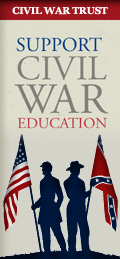|
African American Faces of the Civil War: An Album
By Sara Rosen
Le Journal de la Photographie
October 2012
In February 1865, Martin Delany was received by Abraham Lincoln at the White House. There, Delany told the President, “I propose, sir, an army of blacks, commanded entirely of black officers.” Shortly thereafter, Delany received a commission as major of infantry—the first African American appointed an army officer. As Frederick Douglass reportedly stated, “I thank God for making me a man simply, but Delany always thanks Him for making him a black man.”
The story of Major Martin Robison Delany, Fifty-second U.S. Colored Infantry, is titled “Most Defiant Blackness” and leads with his portrait, dressed in Union blues. This photograph is a cartes de visite, taken with a specially designed camera that produced eight images on a single glass plate, from which the resulting paper print. It was then glued to card stock and measured 2.5 x 4 inches in size, the perfect keepsake that was economically possible at this time. From 1851–67, “cartonamia” was unleashed, with some three million cartes de visite sold. This was the first time almost anyone could record his or her own image for posterity, and they immediately became decorative objects that made picture giving a cultural phenomeon. Not to mention a resource for an author as industrious as Ronald S. Coddington.
Coddington has just released his third book, African American Faces of the Civil War: An Album (Johns Hopkins University Press), a beautiful and meticulous presentation of the likenesses and lives of seventy-seven men whose stories are part of the complex and compelling tapestry that is America. These stories offer but a glimpse into the vast ocean of men, some 200,000 African Americans, who served the Union Army and Navy during the Civil War. Some of them were born free, others escaped from slavery or set free by owners sympathetic to the war effort.
And, if only for a moment, imagine what it must have been like, two hundred thousand African American men army and dressed for combat on American soil, ready to fight the white man for freedom, the right to self sovereign. “I am for war—war upon the whites,” Delany wrote during the 1850's a novel that stood in marked contrast to Uncle Tom’s Cabin. Delany’s words are seen in the stories of men who served not only their country but something greater than this. As soldiers in the Civil War, they stood for what the United States was founded upon: Independence.
The stories provide a reverent context for the images we witness here. They lend a gravitas to the images, which charming in their dated stylistic iconography, the way in which the photograph easily replaces the painted portrait while assuming all of its conventions. Consider the portrait of Corp. Jeremiah Saunders, Company K, 124 U.S. Colored Infantry, and his wife Emily. His master died in Kentucky in February 1865, he was not free for the Emancipation Proclamation only liberated those in the seceded states. Nevertheless, Saunders left the tobacco fields and headed straight to Camp Nelson, a Union establishment. There he signed his enlistment papers with an “X” and joined the 124 U.S. Colored Infantry, a regiment composed of men between 35¬45, considered too old for active duty. And though he was not on the front lines, still he served. For this book proves that for all the darkness of humanity that does occur, the wheel of fortune will always turn. And though one might be born a slave, degraded in countless ways, there might just be another destiny that is meant to be. African American Faces of the Civil War: An Album serves us well to remind us of those who came before and honor them for these are the heroes we need today, the lives and lessons of humble greatness.
|
|
